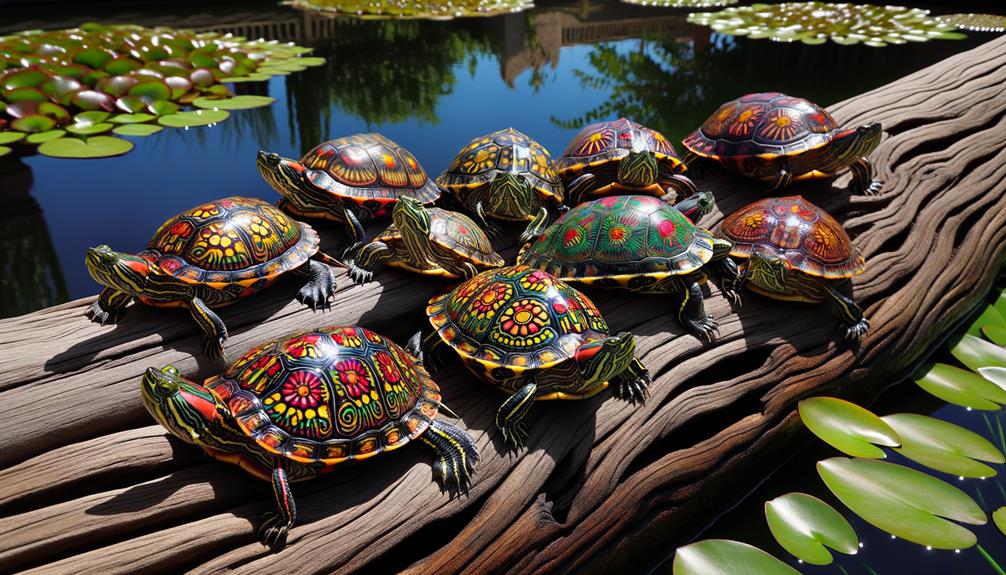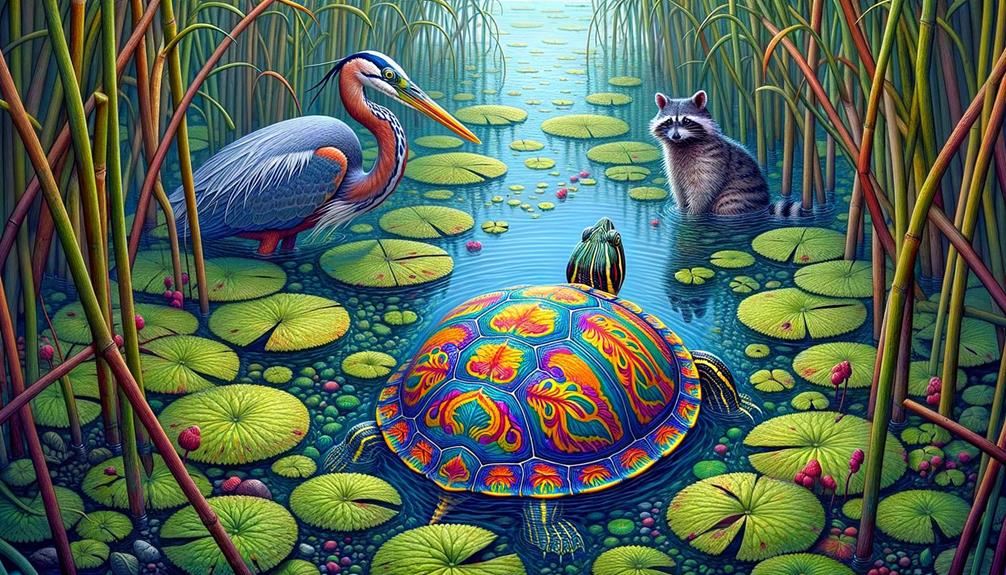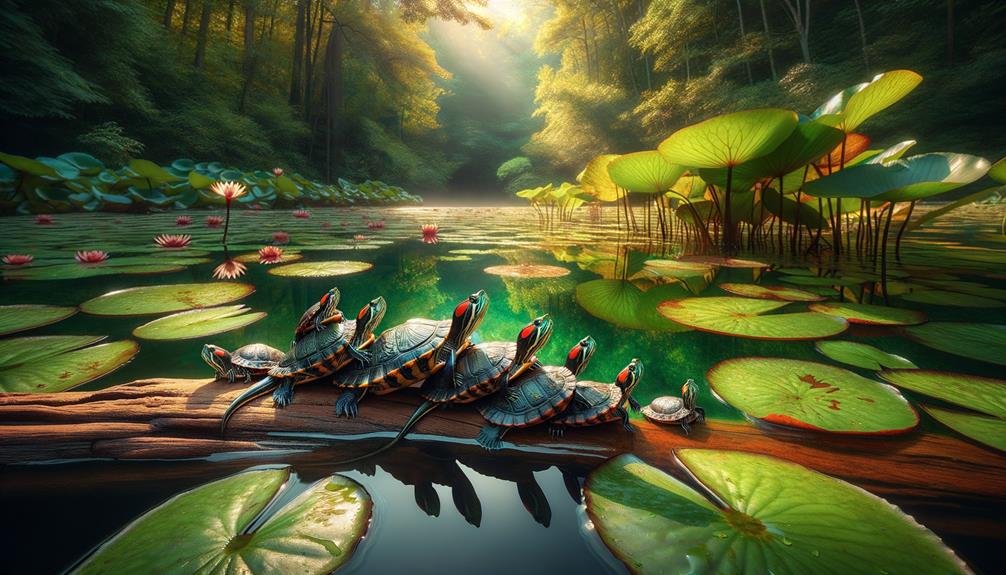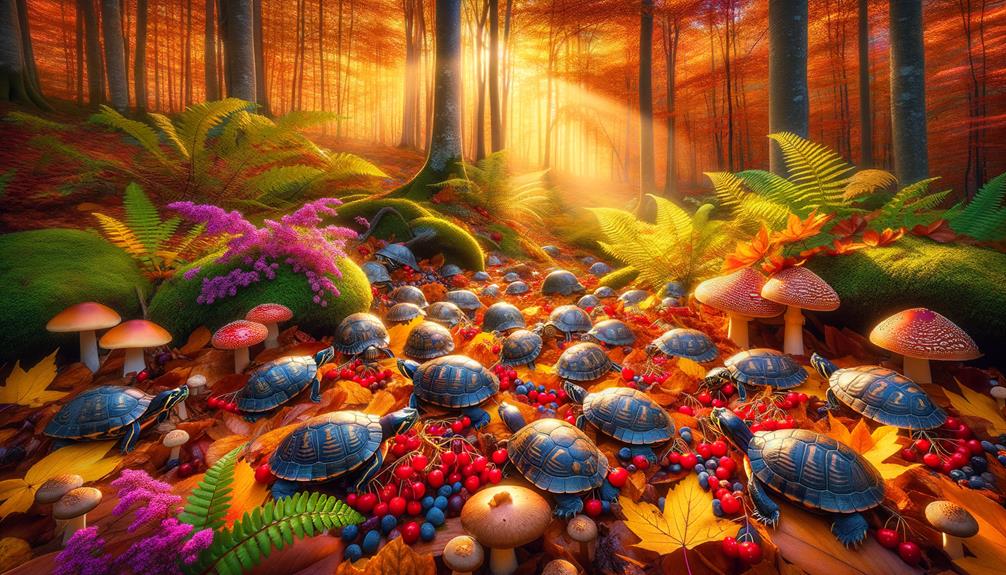Here's a rewritten version of the text, following the provided instructions:
Painted turtles have always fascinated me with their striking appearance – dark brown or black skin highlighted by vibrant red and yellow streaks. These small swimmers thrive in North America's calm waters, from the Atlantic to the Pacific coast. They're often spotted basking on logs or rocks, quickly leaping into the water when startled. Female painted turtles lay eggs in early summer, and the hatchlings emerge in late summer. Unfortunately, they face threats from predators and human activities. In many cultures, painted turtles symbolize longevity and life cycles, holding significance in Native American, Japanese, and Chinese traditions. If you're curious about how they adapt and survive in their habitats, read on to learn more!
Key Takeaways
Painted turtles boast striking colours, with dark brown or black skin adorned with vibrant red and yellow streaks. Their shells showcase dark brown hues with flashes of bright red along the edges. These turtles are agile swimmers and frequent baskers, often perching on logs or rocks to soak up the sun. They thrive in still water habitats teeming with aquatic vegetation and muddy bottoms. In many cultures, painted turtles hold significant cultural meaning, symbolizing longevity and good fortune.
Habitat and Distribution
From serene ponds to marshy streams, painted turtles thrive in still water habitats across North America. I've always been fascinated by their adaptability and preference for environments that offer both security and abundance. These turtles can be found from the Atlantic to the Pacific, with each region hosting its unique type – Eastern, Midland, Western, and Southern. Despite their slight differences in appearance, all painted turtles share a love for slow-moving or still waters rich in aquatic vegetation and muddy bottoms.
I often spot these turtles in ponds or marshes, where they bask on logs, rocks, or shorelines, soaking up the sun. When they sense danger, they swiftly plunge into the water, seeking refuge. Their bottom shells, or plastrons, provide them with some protection as they retreat to the safety of the murky depths.
What's fascinating is how these habitats support their lifestyle. The muddy bottoms offer ideal conditions for hiding and hunting, while the aquatic vegetation provides both food and shelter. Painted turtles embody a spirit of freedom and resilience, thriving in environments that many might overlook. It's a reminder that sometimes the most vibrant lives are lived in the quieter, stiller places.
Physical Characteristics

Observing painted turtles in their natural habitats, I'm struck by their distinct physical characteristics that make them so captivating. Their dark brown or black skin is adorned with vibrant red and yellow streaks, creating a striking contrast that catches the eye. The shell, or carapace, is equally fascinating, with its dark brown hue edged in vibrant red flashes. Painted turtles typically reach a size of about 7 inches, making them a perfect blend of compactness and visibility in their aquatic environments.
Imagine this vivid image:
- Skin: Dark brown or black, crisscrossed with bright red and yellow streaks.
- Shell: Dark brown, rimmed with red, providing a dramatic border.
- Size: A compact 7 inches, just the right size to spot but not overwhelm.
- Behavior: Active swimmers and frequent baskers on logs or rocks.
These turtles thrive in various still water bodies, such as ponds, marshes, and slow streams, preferring areas with muddy bottoms and lush vegetation. Watching them submerge into the water at the slightest approach is a reflection of their lively and cautious nature. Their unique physical traits and behaviors truly make painted turtles colorful favorites in the wild.
Life Cycle and Reproduction

Witnessing the life cycle and reproduction of painted turtles is a fascinating experience, offering a glimpse into the intricacies of nature. It begins when these turtles reach sexual maturity around ten years old, marking the start of their contribution to the next generation. In early spring, the breeding season commences, and by May to June, female painted turtles are busy nesting. They carefully select sites to lay their eggs, typically between 2-8, which will incubate for up to 80 days.
When late summer arrives, the hatchlings emerge, but they don't immediately venture out. Instead, they remain in the nest until the following spring, allowing them to grow stronger and better equipped for survival. During this time, they focus on consuming protein-rich food sources, essential for rapid growth. As they mature, their diet diversifies, and they become omnivorous, feeding on insects, small fish, algae, and vegetation.
In the wild, painted turtles can live impressive lives spanning 20-40 years, provided they survive the vulnerable early stages. Observing this cycle, from fragile egg to mature turtle, highlights the resilience and adaptability of these colorful creatures, showcasing the wonders of the natural world.
Predators and Threats

As we delve into the remarkable resilience and adaptability of painted turtles' life cycles, it's crucial to acknowledge the numerous predators and threats that challenge their survival. From the moment their eggs are laid, these vibrant creatures face a multitude of dangers. Predators, intent on snatching an easy meal, pose a constant threat to their nests and hatchlings. Among the primary culprits are:
- Raccoons and Skunks: These mammals are notorious for raiding turtle nests, devouring eggs and hatchlings.
- Foxes: Agile and cunning, foxes also target nests, further depleting the number of young turtles that make it to the water.
- Snakes: Many snake species find juvenile turtles an irresistible snack, preying on them when they are most vulnerable.
- Human Activities: From vehicular collisions to lawn mowing, human actions unintentionally but profoundly impact turtle populations.
Hatchlings and juveniles are especially at risk, and their survival during the early years is pivotal for the species' longevity. Adding to these immediate threats is the overarching issue of habitat loss due to human development. Climate change and pollution also cast a long shadow over the future of painted turtles. Despite their adaptability, these threats underscore the precarious balance they must navigate to endure.
Cultural Significance

Throughout history, painted turtles have been imbued with deep symbolic meaning and cultural significance across various societies worldwide. In Native American tribes like the Ojibwe and Lakota, these turtles embody the earth and life cycles, highlighting the interconnectedness of nature. Their presence in folklore and spiritual practices underscores their importance in Indigenous cultures.
In Japan, the painted turtle is a symbol of longevity and good fortune. Traditional artwork and decorative motifs often feature these turtles, serving as a reminder of the virtues of a long, prosperous life. In traditional Chinese medicine, painted turtles are revered for their perceived healing properties, particularly in treating respiratory ailments. Their use in ancient remedies reflects a cultural belief in the natural world's ability to heal.
The intricate shell patterns of painted turtles have inspired various artistic expressions. Indigenous cultures have incorporated these designs into textiles, pottery, and other forms of art, celebrating the turtle's beauty and symmetry. Moreover, the painted turtle's designation as the official state reptile in several U.S. states showcases its lasting cultural and ecological importance.
Frequently Asked Questions
What Is a Painted Turtle's Favorite Food?
I love watching painted turtles munch on tender duckweed or chase after wriggling insects. Their favorite food varies, but they can't resist a juicy worm or a succulent piece of aquatic plant, blending nature's bounty seamlessly into their diet.
Do Painted Turtles Show Affection?
Painted turtles don't form close bonds with humans like other pets might. They're driven by instinct and are naturally solitary, so while they can get comfortable with your presence, they won't develop emotional connections with you. Providing proper care ensures their health and well-being.
Do Painted Turtles Like to Be Held?
While I love the idea of bonding with my painted turtle, they simply don't enjoy being held. Handling them often causes them stress and disrupts their natural behavior. Instead, I focus on creating a comfortable habitat for them.
What Is the Lifespan of a Painted Turtle?
The lifespan of a painted turtle can extend up to 40 years in the wild, while in captivity, they typically live for 20-25 years. To ensure they live a long life, it's vital to provide proper care, including a balanced diet, a suitable habitat, and regular veterinary check-ups.



